Tone Arms & Speakers—thats what Rexonola called their reproducers / sound-boxes!
Rexonola Tone Arms
Rexonola speakers are interchangeable—any speaker can be fitted to any Rexonola tone-arm. Unfortunately, restrictions on metals imposed as a result of World War I, meant that numerous arms were manufactured from pot-metal.
Acoustic era Rexonolas used two basic types of nickel plated tone arms. Cheaper table-top units came fitted with a rigid straight arm which did not facilitate needle change by permitting the reproducer to be swung back and inverted. All other acoustic Rexonolas were fitted with a ‘swan-neck’ tapered tone arm (two variants of which are shown below), which resembles the arm fitted to many Victrolas.
c1923 Rigid, straight arm & ‘Concert’ speaker
Inexpensive lid-less table-top Model
No.17
c1924: ‘Standard’ speaker and ‘swan-neck’ tapered arm
Model No.4

c1916: Rexonola Grand ‘Autophonic’
speaker and ‘swan-neck’ tapered arm
from a Model No.2; note that this
‘swan-neck’ arm differs to the example shown above
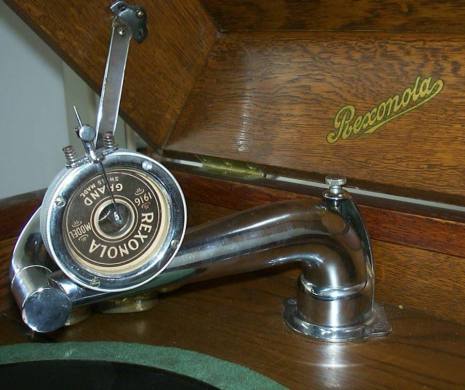
With the dawn of the electrical recording era, Rexonola ‘Prismaphonic’ models were developed. These were provided with a new (patented 1927) high quality ‘S-shaped’, tapered, nickeled brass tone arm. ‘Prismaphonic’ Rexoports were fitted with modified versions of this new arm, to suit case configuration.
1928: ‘Rexophonic’ speaker on ‘S-shaped’ tapered arm—‘Model 30 Prismaphonic’
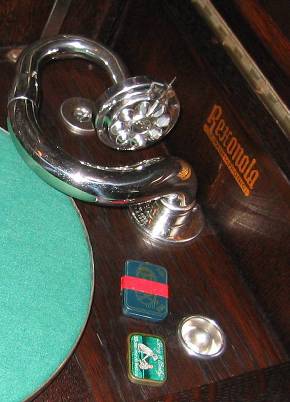
1927: ‘Rexophonic’ speaker on Rexoport tapered arm—Rexoport Prismaphonic Model L
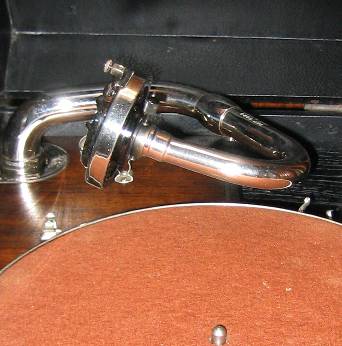
Rexonola ‘Standard or Nickel Grand’ & Rexonola ‘Concert’ Reproducers
In the acoustic recording era, Rexonola used three Swiss made reproducers—a pot-metal unit, the ‘Standard’ or ‘Nickel Grand’, the aluminium bodied ‘Concert’ and the upmarket ‘Autophonic’ or ‘Aluminium Grand’. All employed 52 mm mica diaphragms.
In my opinion the ‘Standard’ is much better than the supposedly superior and more expensive ‘Autophonic’. Though made of pot-metal and therefore potentially fragile (especially susceptible to fracture at the tone arm attachment flange) the ‘Standard’ sounds every bit as good as and weighs heaps less than the more handsome looking ‘Autophonic’.
I would guess the ‘Standard’ weighs in under the 90 gm maximum recommended tracking weight for 78 rpm recordings. By comparison, the ‘Autophonic’ weighs a whoppin’ 142 gm—and the ‘Rexophonic’ is more massive still at 173 gm!
A good well adjusted ‘Standard’ is my Rexonola sound-box of choice—because it treads more lightly on old 78’s... by doing so I hope record wear is significantly reduced and the recordings will be preserved for a few more generations to enjoy.
c1918 Rexonola ‘Standard or Nickel Grand’ speaker —Model No. 4
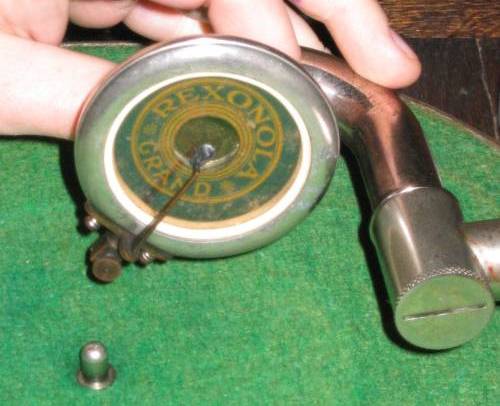
c1923 Rexonola ‘Concert’ speaker —Model No. 17
Rexonola ‘Autophonic’ or ‘Aluminium Grand’ Reproducer
The ‘Autophonic’ reproducer, like the ‘Standard’ also employs a 52 mm mica diaphragm and was designed to play records produced during the acoustic (pre-electric) recording era, prior to 1926. The ‘Autophonic’ is considerably more complex and sophisticated than the ‘Standard’. It looks pretty ’cause the removable ring securing the diaphragm is gilded or gold plated—though the gold has been lost on many examples due to mis-treatment and oxidation. The ‘Autophonic’ is interchangeable with the ‘Standard’ and ‘Rexophonic’ speakers. See comments above regarding the ‘Autophonics’ high weight and potential for adverse record wear.
1916: Rexonola ‘Autophonic’ Speaker —also called a ‘Rexonola Aluminium Grand Sound Box’

Circa late 1929, Rexoports (and possibly cabinet models too) appeared fitted with a new metal diaphragm reproducer stamped ‘Autophonic’. This resembles the ‘Rexophonic’ shown below but weighs somewhat less. Given the era in which it appeared, and the metallic diaphragm, it was certainly intended for electrical recordings and can possibly be considered a later version of the original mica ‘Autophonic’ above.
1929: New style ‘Autophonic’ Speaker fitted to a late model Rexoport
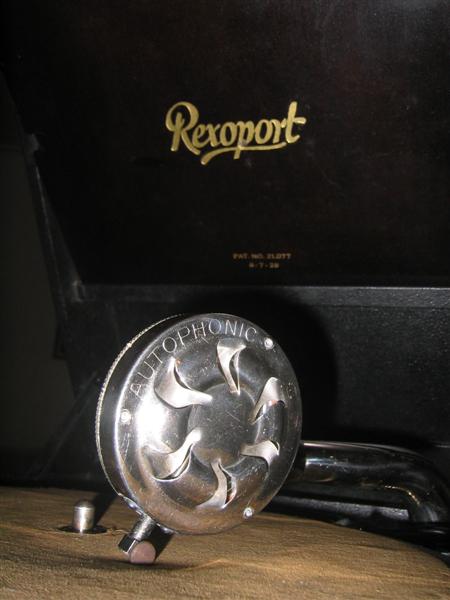
‘Rexophonic’ or ‘Prismaphonic’ Speaker
Introduced in response to electrical recordings, to exploit the greater tonal range of the new process. The ‘Rexophonic’ reproducer, when paired with the ‘Prismatic’ horn, gave rise to the Rexonola ‘Prismaphonic’ range of instruments...which are considered truly fine sounding machines by many experienced Australian collectors who compare it favourably with the HMV /Victor ‘Orthophonic’. The ‘Rexophonic’ reproducer is a well machined, nickeled brass, Swiss made unit. It employs a corrugated aluminium diaphragm and weighs in at a hefty 173 gm—way to heavy for my liking (refer comments concerning tracking weight and record wear above).
In the Rexonola ‘Prismaphonic’ models, the ‘Rexophonic’ reproducer was mated to a new S-shaped tapered tone arm
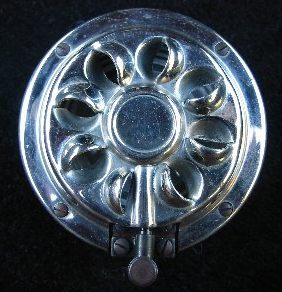
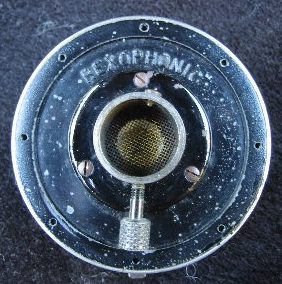
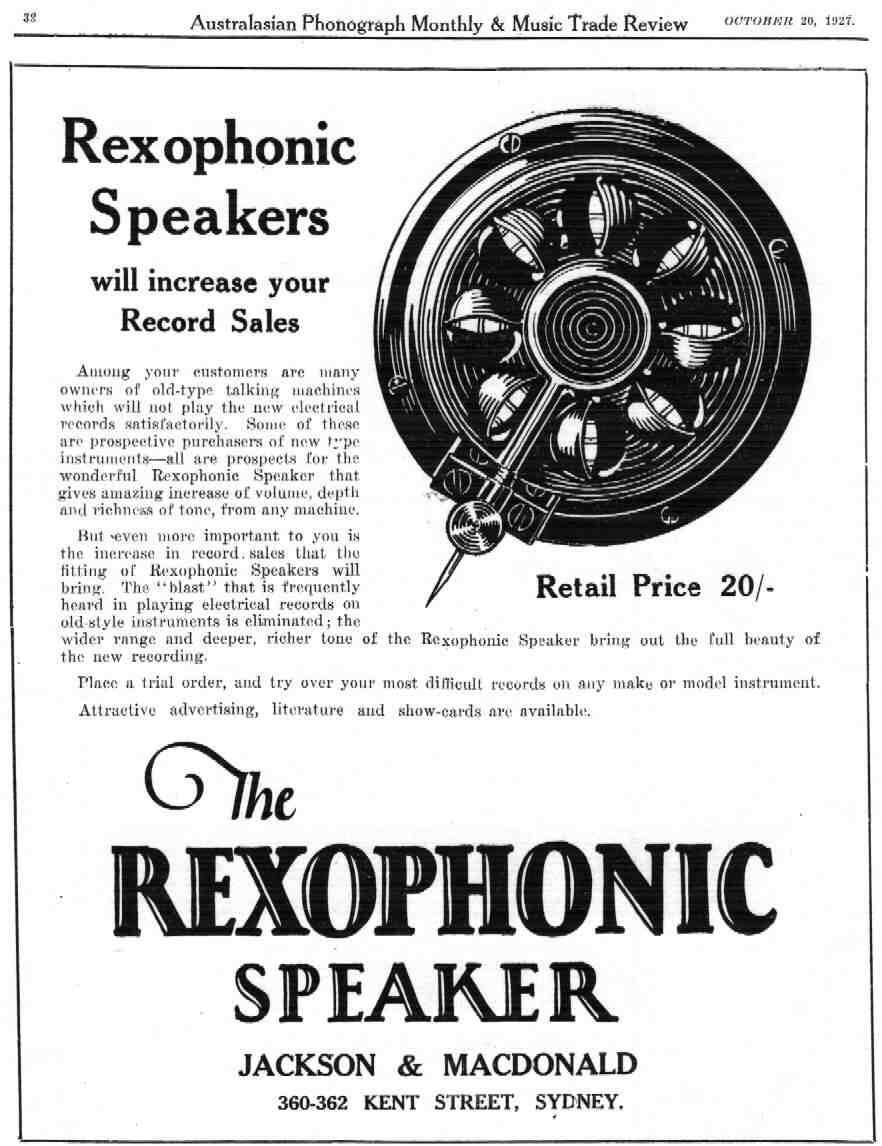
Back...
Edited: Wednesday,
11 September 2024; 16:10 hrs